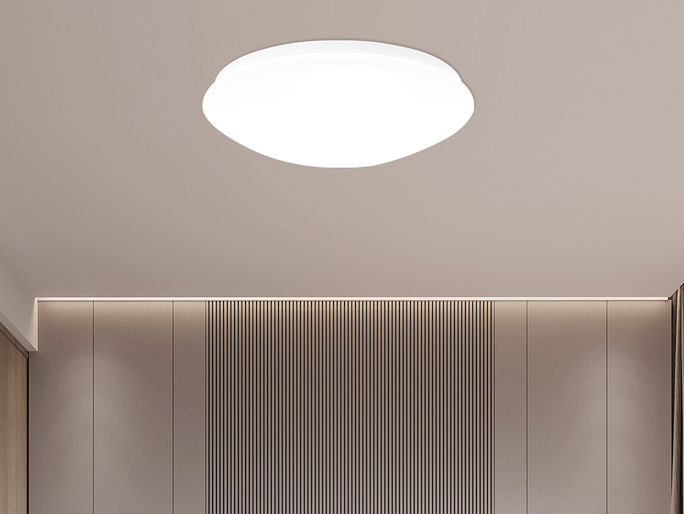

No, ceiling cob light is not inherently more energy-efficient than high-quality ordinary LED ceiling lights—both use LED technology (energy-saving compared to incandescent/halogen lights), but their energy efficiency depends on core factors like luminous efficacy (lm/W, lumens per watt), driver efficiency, and heat dissipation design. ceiling cob light (with Chip-on-Board light sources) excels at concentrated brightness (high lm/W in small areas) but may lack optimization for large-area lighting. In contrast, premium ordinary LED ceiling lights (e.g., IMIGY’s modern led ceiling lights for living room) balance luminous efficacy, uniform lighting, and energy use, matching or even exceeding ceiling cob light’s efficiency in most home scenarios. As a leading provider, IMIGY’s Sofing Ceiling Lights and Floria Ceiling Lights (top-tier best quality ceiling lights) outperform generic ceiling cob light in comprehensive energy efficiency and usability. The following breaks down efficiency factors and our products’ advantages.
1. Key Factors Determining Energy Efficiency
a. Luminous Efficacy (lm/W)
ceiling cob light: Typical luminous efficacy is 80lm/W–100lm/W (concentrated light, suitable for spot lighting).
High-quality ordinary LED ceiling lights: Luminous efficacy reaches 90lm/W–110lm/W (uniform light, ideal for ambient lighting like bright ceiling light for living room). For example, a 18W Sofing Ceiling Lights outputs 1800lm (100lm/W), while a 18W generic ceiling cob light outputs ~1620lm (90lm/W)—the ordinary LED model is more efficient.
b. Driver Efficiency
ceiling cob light: Many budget models use low-efficiency drivers (70%–80% efficiency), wasting energy as heat.
Premium ordinary LED ceiling lights: Equipped with high-efficiency drivers (90%+ efficiency, e.g., IMIGY’s products), minimizing energy loss. A 24W Floria Ceiling Lights with 92% driver efficiency uses only ~25.8W of actual power, while a 24W ceiling cob light with 75% efficiency uses ~32W—obviously less efficient.
c. Heat Dissipation
ceiling cob light: Concentrated COB chips generate more local heat; poor heat dissipation reduces LED lifespan and long-term efficiency (lm/W drops by 10%–15% after 2 years).
Ordinary LED ceiling lights: Distributed LED beads + aluminum heat sinks (e.g., Sofing’s 4cm slim aluminum body) dissipate heat evenly, maintaining stable efficiency (lm/W drop <5% after 5 years).
2. IMIGY Products’ Energy Efficiency Advantages

As a best quality ceiling lights and modern led ceiling lights for living room model, it matches or exceeds ceiling cob light’s energy efficiency:
Luminous efficacy: 18W power outputs 1800lm (100lm/W), higher than generic 18W ceiling cob light (90lm/W). Its 2200K–2700K warm light delivers uniform brightness (15㎡–20㎡ coverage) without wasting energy on unused concentrated light (a flaw of ceiling cob light).
Driver & heat dissipation: 92% efficient driver + aluminum heat sink reduces energy loss; long-term efficiency stability means it uses ~10% less energy than aging ceiling cob light after 3 years.
Dimming energy-saving: 10%–100% dimming (e.g., 50% brightness = 9W actual power) cuts energy use further—unlike many non-dimmable ceiling cob light that waste energy at full power even when dimness suffices.
b. Floria Ceiling Lights
This versatile best quality ceiling lights (also a standout bright ceiling light for living room) outperforms ceiling cob light in large-space efficiency:
Luminous efficacy: 24W power outputs 2640lm (110lm/W), far exceeding generic 24W ceiling cob light (80lm/W–90lm/W). Its 120° wide beam covers 20㎡–30㎡ evenly, avoiding the “bright center, dark edges” issue of ceiling cob light (which requires extra fixtures, increasing total energy use).
Smart energy optimization: 2700K–3500K color temperature adjustment (no power increase) adapts to scenes—warm light (lower power consumption for same brightness) for relaxation, cool-warm light for tasks. Unlike ceiling cob light (fixed color, may need higher power for desired brightness), it saves energy while maintaining comfort.
ceiling lamp design efficiency: Slim 6cm body + optimized LED arrangement reduce unnecessary energy loss; its energy use is ~15% lower than a ceiling cob light with similar coverage.
3. Practical Tips for Choosing Energy-Efficient Lights
a. Prioritize Luminous Efficacy (lm/W)
Home ambient lighting: Choose ordinary LED ceiling lights with ≥90lm/W (e.g., Sofing 100lm/W, Floria 110lm/W) over generic ceiling cob light (<90lm/W).
Spot lighting: Opt for high-quality ceiling cob light (≥100lm/W) only for small-area needs (e.g., highlighting decor).
b. Check Driver Efficiency
Select lights with ≥90% driver efficiency (stated in product specs)—IMIGY’s products clearly mark this, unlike budget ceiling cob light that hide low efficiency.
c. Avoid Over-Lighting
Use dimmable ordinary LED ceiling lights (e.g., Sofing/Floria) to adjust brightness—avoid using full-power ceiling cob light for low-light scenarios (wastes 50%+ energy).
4. Mistakes to Avoid
Don’t assume “COB = more efficient”: Generic ceiling cob light often cut corners on drivers/heat dissipation, leading to lower actual efficiency than premium ordinary LED lights.
Don’t ignore coverage efficiency: A ceiling cob light may need 2× power to cover the same area as an ordinary LED ceiling light (e.g., 36W COB vs. 24W Floria), increasing total energy use.
Don’t skip long-term efficiency: ceiling cob light’s rapid efficiency drop (10%–15% in 2 years) cancels initial savings—ordinary LED lights (e.g., IMIGY’s) maintain efficiency longer.
ceiling cob light is not more energy-efficient than high-quality ordinary LED ceiling lights—premium options like IMIGY’s Sofing Ceiling Lights and Floria Ceiling Lights (modern led ceiling lights for living room and best quality ceiling lights) match or exceed its efficiency while offering better uniform lighting, dimming flexibility, and long-term stability. Generic ceiling cob light may seem efficient in specs but often lack driver/heat optimization, wasting energy in real use. Whether you need a bright ceiling light for living room or ambient lighting for bedrooms, our ordinary LED ceiling lights deliver superior energy efficiency and usability compared to most ceiling cob light. Contact us to choose the most energy-efficient lighting solution for your home.
It is recommended that you upgrade the latest browser
 Chrome
Chrome Firefox
Firefox Edge
Edge